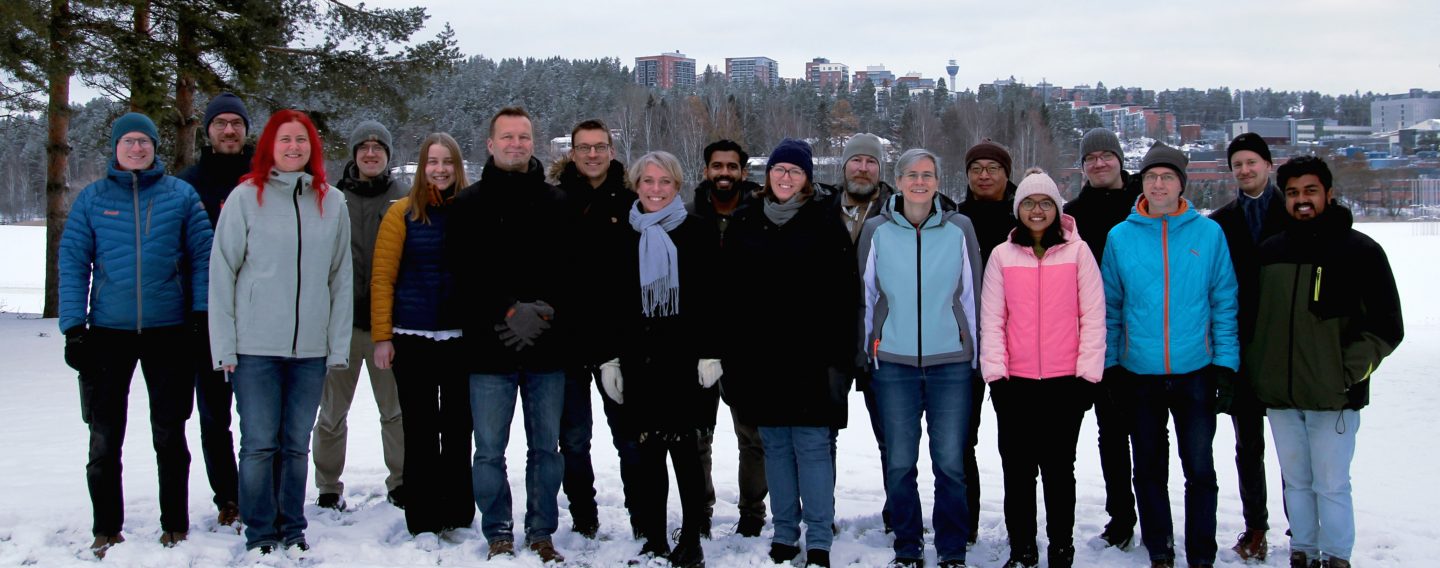Atmospheric Aerosol Physics
The research carried out in the Aerosol Physics Group is focused on atmospheric aerosols, which are liquid or solid particles suspended in the atmosphere. The group studies how atmospheric aerosols form and the role they play in the Earth’s climate through their interactions with clouds. The group has a unique capability of integrating laboratory and outdoor measurements with theories and models in order to understand and predict the impacts of human-caused and natural changes on climate. Aerosol physics group is in central role in UEF top level strategic profiling area Environmental change and sustainable use of natural resources.
Aerosol research group in UEF concentrates on four main topics
SOA formation and properties
Secondary organic aerosol (SOA) refers to the aerosol material that is formed when volatile organic compounds from biogenic and anthropogenic sources oxidize and form condensable vapors. SOA is known to form a significant fraction of atmospheric aerosols but large uncertainties are still associated with the identities of the participating compounds and their properties. This reflects as an uncertainty in the global atmospheric model simulations. Our group studies SOA formation and properties by combining experimental and modelling methods. The measurement infrastructure includes e.g. multiple atmospheric simulation chambers and the measurements station at the top of the Puijo-tower. In the modelling the emphasis is on the dynamics and thermodynamics of the SOA related processes. In our research on SOA formation and properties we concentrate especially on:
- emissions of volatile organic compounds from plants and their SOA yields
- gas-particle partitioning and particle phase processes
- solid phase and phase transitions of secondary organic aerosols
Aerosol-cloud interactions
Aerosol particles act as nuclei for cloud droplets in the atmosphere. Aerosols are, therefore, important players in determining the properties and lifetimes of cloud properties, and the aerosol-cloud interactions have a significant role in the Earth’s climate system. The size and composition of an aerosol particle affects its ability to act as cloud condensation nuclei. There are still unknowns in the composition dependence of the cloud droplet forming ability, especially for the organic aerosols. Our laboratory facilities and instrumentation allows as to study water uptake of model aerosol systems. The unique measurement station at the top of the Puijo-tower, which is maintained in collaboration with the Finnish Meteorological Institute, facilitates in-cloud measurements of aerosol properties and cloud droplet activation. Our group’s research objects related to aerosol-cloud interactions are:
- hygroscopicity of aerosol particles under sub- and super-saturation
- cloud droplet activation
Anthropogenic-Biogenic interactions
In the natural atmosphere, anthropogenic and biogenic sources of pollutants do not exist in isolation, and the potential interaction between the two pollutant sources has raised particular scientific interest. Comprehensive study of the interactions between anthropogenic and biogenic emissions is a necessity for acquiring the better understanding of atmospheric composition and climate change. To investigate the interactions we have developed a unique research environment ILMARI, a top-class laboratory facility allowing the utilization of vehicle and biomass combustion emissions and VOC emissions from real plants in our experimental SOA studies. Our research focuses to explore the impact of anthropogenic emissions on biogenic SOA formation and its climate-relevant characteristics.
Representation of aerosols in Climate modelling
In the aerosol modelling group we are working with models at different scales. Modelling aerosol chemistry and condensation at a very detailed level, we are able to study the effect of aerosol and gas phase composition on cloud droplet formation. Using such models we have, for instance, studied how the number concentration of cloud droplets is affected by the properties of surface active compounds, or by the partitioning between gas and liquid phase of semivolatile compounds.
With the global models we are mainly interested on what is the role of aerosol particles and aerosol cloud interactions on global radiation budget. For that purpose computationally efficient aerosol modules need to be developed and coupled to climate models. With these computationally efficient models it is not possible to represent all the details studied with more complex models, and thus the group is developing parameterizations so that all the relevant processes could be taken into account with global models.
